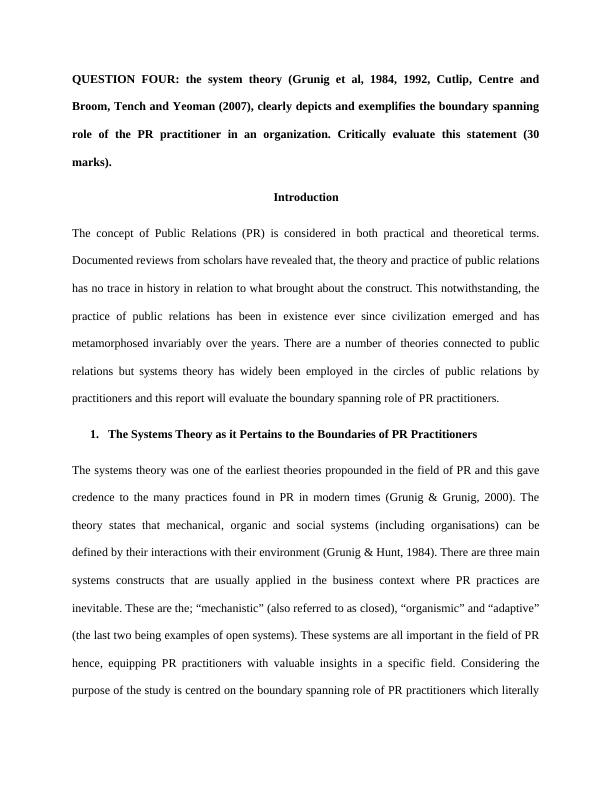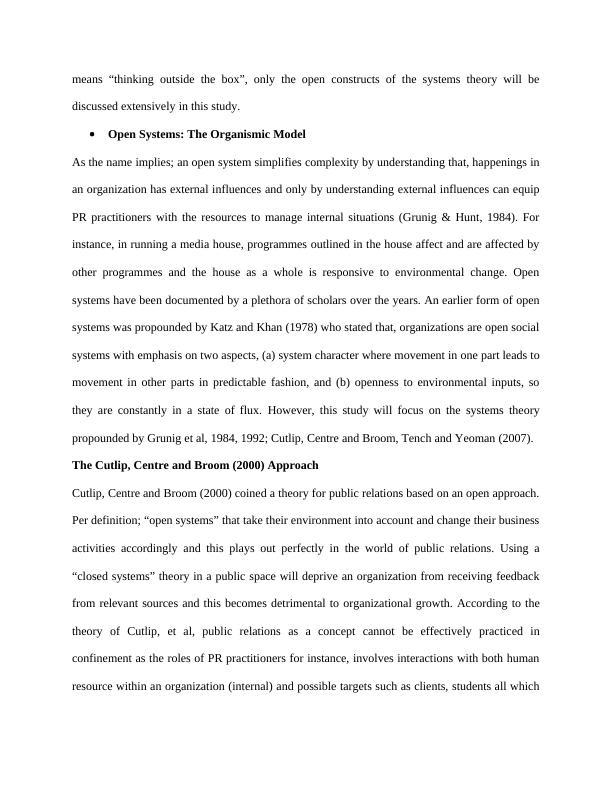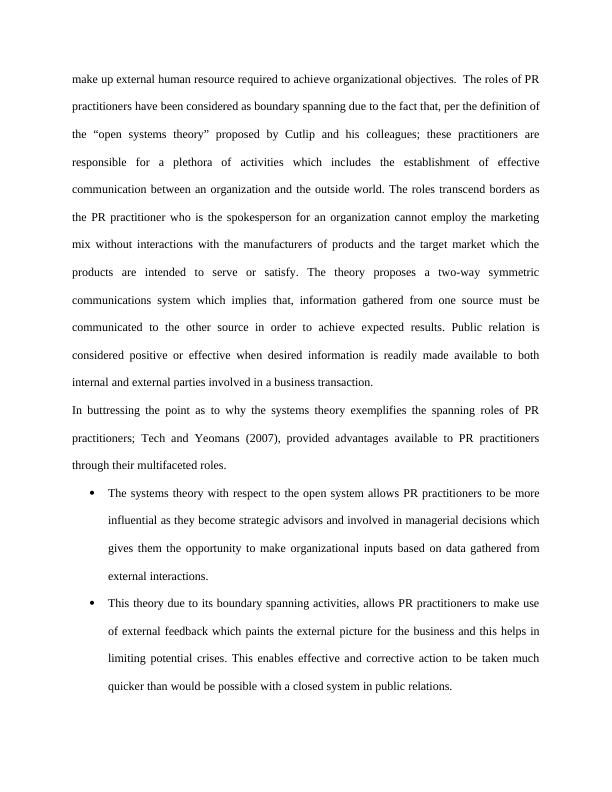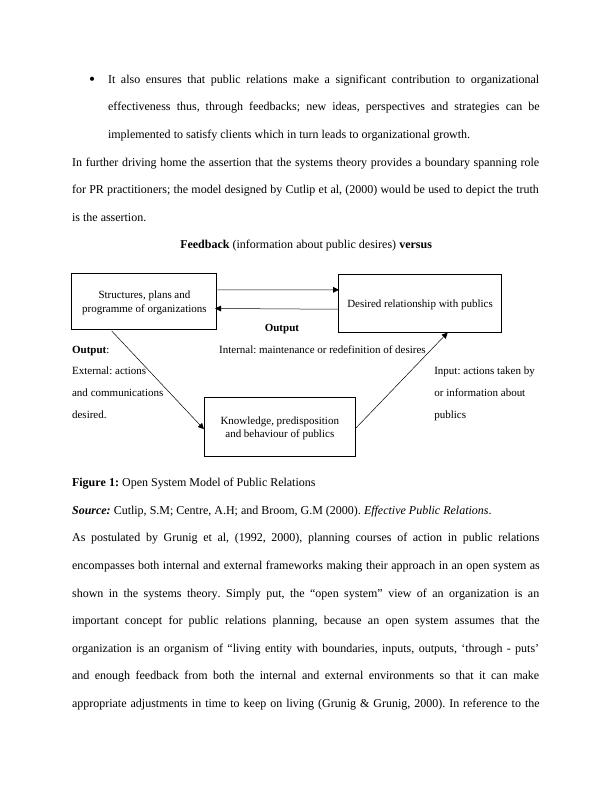Ask a question from expert
system theory Assignment PDF
12 Pages3562 Words79 Views
Added on 2021-10-09
system theory Assignment PDF
Added on 2021-10-09
BookmarkShareRelated Documents
QUESTION FOUR: the system theory (Grunig et al, 1984, 1992, Cutlip, Centre and
Broom, Tench and Yeoman (2007), clearly depicts and exemplifies the boundary spanning
role of the PR practitioner in an organization. Critically evaluate this statement (30
marks).
Introduction
The concept of Public Relations (PR) is considered in both practical and theoretical terms.
Documented reviews from scholars have revealed that, the theory and practice of public relations
has no trace in history in relation to what brought about the construct. This notwithstanding, the
practice of public relations has been in existence ever since civilization emerged and has
metamorphosed invariably over the years. There are a number of theories connected to public
relations but systems theory has widely been employed in the circles of public relations by
practitioners and this report will evaluate the boundary spanning role of PR practitioners.
1. The Systems Theory as it Pertains to the Boundaries of PR Practitioners
The systems theory was one of the earliest theories propounded in the field of PR and this gave
credence to the many practices found in PR in modern times (Grunig & Grunig, 2000). The
theory states that mechanical, organic and social systems (including organisations) can be
defined by their interactions with their environment (Grunig & Hunt, 1984). There are three main
systems constructs that are usually applied in the business context where PR practices are
inevitable. These are the; “mechanistic” (also referred to as closed), “organismic” and “adaptive”
(the last two being examples of open systems). These systems are all important in the field of PR
hence, equipping PR practitioners with valuable insights in a specific field. Considering the
purpose of the study is centred on the boundary spanning role of PR practitioners which literally
Broom, Tench and Yeoman (2007), clearly depicts and exemplifies the boundary spanning
role of the PR practitioner in an organization. Critically evaluate this statement (30
marks).
Introduction
The concept of Public Relations (PR) is considered in both practical and theoretical terms.
Documented reviews from scholars have revealed that, the theory and practice of public relations
has no trace in history in relation to what brought about the construct. This notwithstanding, the
practice of public relations has been in existence ever since civilization emerged and has
metamorphosed invariably over the years. There are a number of theories connected to public
relations but systems theory has widely been employed in the circles of public relations by
practitioners and this report will evaluate the boundary spanning role of PR practitioners.
1. The Systems Theory as it Pertains to the Boundaries of PR Practitioners
The systems theory was one of the earliest theories propounded in the field of PR and this gave
credence to the many practices found in PR in modern times (Grunig & Grunig, 2000). The
theory states that mechanical, organic and social systems (including organisations) can be
defined by their interactions with their environment (Grunig & Hunt, 1984). There are three main
systems constructs that are usually applied in the business context where PR practices are
inevitable. These are the; “mechanistic” (also referred to as closed), “organismic” and “adaptive”
(the last two being examples of open systems). These systems are all important in the field of PR
hence, equipping PR practitioners with valuable insights in a specific field. Considering the
purpose of the study is centred on the boundary spanning role of PR practitioners which literally

means “thinking outside the box”, only the open constructs of the systems theory will be
discussed extensively in this study.
Open Systems: The Organismic Model
As the name implies; an open system simplifies complexity by understanding that, happenings in
an organization has external influences and only by understanding external influences can equip
PR practitioners with the resources to manage internal situations (Grunig & Hunt, 1984). For
instance, in running a media house, programmes outlined in the house affect and are affected by
other programmes and the house as a whole is responsive to environmental change. Open
systems have been documented by a plethora of scholars over the years. An earlier form of open
systems was propounded by Katz and Khan (1978) who stated that, organizations are open social
systems with emphasis on two aspects, (a) system character where movement in one part leads to
movement in other parts in predictable fashion, and (b) openness to environmental inputs, so
they are constantly in a state of flux. However, this study will focus on the systems theory
propounded by Grunig et al, 1984, 1992; Cutlip, Centre and Broom, Tench and Yeoman (2007).
The Cutlip, Centre and Broom (2000) Approach
Cutlip, Centre and Broom (2000) coined a theory for public relations based on an open approach.
Per definition; “open systems” that take their environment into account and change their business
activities accordingly and this plays out perfectly in the world of public relations. Using a
“closed systems” theory in a public space will deprive an organization from receiving feedback
from relevant sources and this becomes detrimental to organizational growth. According to the
theory of Cutlip, et al, public relations as a concept cannot be effectively practiced in
confinement as the roles of PR practitioners for instance, involves interactions with both human
resource within an organization (internal) and possible targets such as clients, students all which
discussed extensively in this study.
Open Systems: The Organismic Model
As the name implies; an open system simplifies complexity by understanding that, happenings in
an organization has external influences and only by understanding external influences can equip
PR practitioners with the resources to manage internal situations (Grunig & Hunt, 1984). For
instance, in running a media house, programmes outlined in the house affect and are affected by
other programmes and the house as a whole is responsive to environmental change. Open
systems have been documented by a plethora of scholars over the years. An earlier form of open
systems was propounded by Katz and Khan (1978) who stated that, organizations are open social
systems with emphasis on two aspects, (a) system character where movement in one part leads to
movement in other parts in predictable fashion, and (b) openness to environmental inputs, so
they are constantly in a state of flux. However, this study will focus on the systems theory
propounded by Grunig et al, 1984, 1992; Cutlip, Centre and Broom, Tench and Yeoman (2007).
The Cutlip, Centre and Broom (2000) Approach
Cutlip, Centre and Broom (2000) coined a theory for public relations based on an open approach.
Per definition; “open systems” that take their environment into account and change their business
activities accordingly and this plays out perfectly in the world of public relations. Using a
“closed systems” theory in a public space will deprive an organization from receiving feedback
from relevant sources and this becomes detrimental to organizational growth. According to the
theory of Cutlip, et al, public relations as a concept cannot be effectively practiced in
confinement as the roles of PR practitioners for instance, involves interactions with both human
resource within an organization (internal) and possible targets such as clients, students all which

make up external human resource required to achieve organizational objectives. The roles of PR
practitioners have been considered as boundary spanning due to the fact that, per the definition of
the “open systems theory” proposed by Cutlip and his colleagues; these practitioners are
responsible for a plethora of activities which includes the establishment of effective
communication between an organization and the outside world. The roles transcend borders as
the PR practitioner who is the spokesperson for an organization cannot employ the marketing
mix without interactions with the manufacturers of products and the target market which the
products are intended to serve or satisfy. The theory proposes a two-way symmetric
communications system which implies that, information gathered from one source must be
communicated to the other source in order to achieve expected results. Public relation is
considered positive or effective when desired information is readily made available to both
internal and external parties involved in a business transaction.
In buttressing the point as to why the systems theory exemplifies the spanning roles of PR
practitioners; Tech and Yeomans (2007), provided advantages available to PR practitioners
through their multifaceted roles.
The systems theory with respect to the open system allows PR practitioners to be more
influential as they become strategic advisors and involved in managerial decisions which
gives them the opportunity to make organizational inputs based on data gathered from
external interactions.
This theory due to its boundary spanning activities, allows PR practitioners to make use
of external feedback which paints the external picture for the business and this helps in
limiting potential crises. This enables effective and corrective action to be taken much
quicker than would be possible with a closed system in public relations.
practitioners have been considered as boundary spanning due to the fact that, per the definition of
the “open systems theory” proposed by Cutlip and his colleagues; these practitioners are
responsible for a plethora of activities which includes the establishment of effective
communication between an organization and the outside world. The roles transcend borders as
the PR practitioner who is the spokesperson for an organization cannot employ the marketing
mix without interactions with the manufacturers of products and the target market which the
products are intended to serve or satisfy. The theory proposes a two-way symmetric
communications system which implies that, information gathered from one source must be
communicated to the other source in order to achieve expected results. Public relation is
considered positive or effective when desired information is readily made available to both
internal and external parties involved in a business transaction.
In buttressing the point as to why the systems theory exemplifies the spanning roles of PR
practitioners; Tech and Yeomans (2007), provided advantages available to PR practitioners
through their multifaceted roles.
The systems theory with respect to the open system allows PR practitioners to be more
influential as they become strategic advisors and involved in managerial decisions which
gives them the opportunity to make organizational inputs based on data gathered from
external interactions.
This theory due to its boundary spanning activities, allows PR practitioners to make use
of external feedback which paints the external picture for the business and this helps in
limiting potential crises. This enables effective and corrective action to be taken much
quicker than would be possible with a closed system in public relations.

It also ensures that public relations make a significant contribution to organizational
effectiveness thus, through feedbacks; new ideas, perspectives and strategies can be
implemented to satisfy clients which in turn leads to organizational growth.
In further driving home the assertion that the systems theory provides a boundary spanning role
for PR practitioners; the model designed by Cutlip et al, (2000) would be used to depict the truth
is the assertion.
Feedback (information about public desires) versus
Output
Output: Internal: maintenance or redefinition of desires
External: actions Input: actions taken by
and communications or information about
desired. publics
Figure 1: Open System Model of Public Relations
Source: Cutlip, S.M; Centre, A.H; and Broom, G.M (2000). Effective Public Relations.
As postulated by Grunig et al, (1992, 2000), planning courses of action in public relations
encompasses both internal and external frameworks making their approach in an open system as
shown in the systems theory. Simply put, the “open system” view of an organization is an
important concept for public relations planning, because an open system assumes that the
organization is an organism of “living entity with boundaries, inputs, outputs, ‘through - puts’
and enough feedback from both the internal and external environments so that it can make
appropriate adjustments in time to keep on living (Grunig & Grunig, 2000). In reference to the
Desired relationship with publicsStructures, plans and
programme of organizations
Knowledge, predisposition
and behaviour of publics
effectiveness thus, through feedbacks; new ideas, perspectives and strategies can be
implemented to satisfy clients which in turn leads to organizational growth.
In further driving home the assertion that the systems theory provides a boundary spanning role
for PR practitioners; the model designed by Cutlip et al, (2000) would be used to depict the truth
is the assertion.
Feedback (information about public desires) versus
Output
Output: Internal: maintenance or redefinition of desires
External: actions Input: actions taken by
and communications or information about
desired. publics
Figure 1: Open System Model of Public Relations
Source: Cutlip, S.M; Centre, A.H; and Broom, G.M (2000). Effective Public Relations.
As postulated by Grunig et al, (1992, 2000), planning courses of action in public relations
encompasses both internal and external frameworks making their approach in an open system as
shown in the systems theory. Simply put, the “open system” view of an organization is an
important concept for public relations planning, because an open system assumes that the
organization is an organism of “living entity with boundaries, inputs, outputs, ‘through - puts’
and enough feedback from both the internal and external environments so that it can make
appropriate adjustments in time to keep on living (Grunig & Grunig, 2000). In reference to the
Desired relationship with publicsStructures, plans and
programme of organizations
Knowledge, predisposition
and behaviour of publics

End of preview
Want to access all the pages? Upload your documents or become a member.